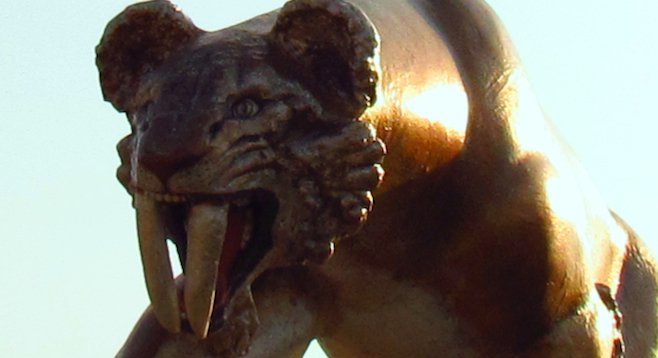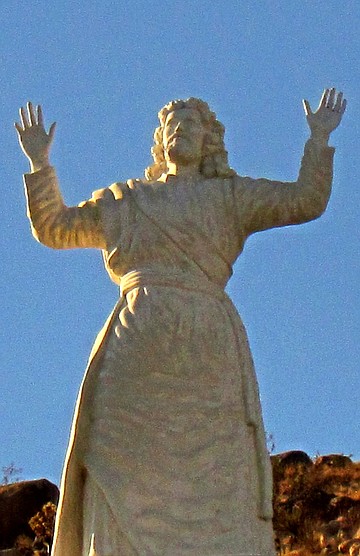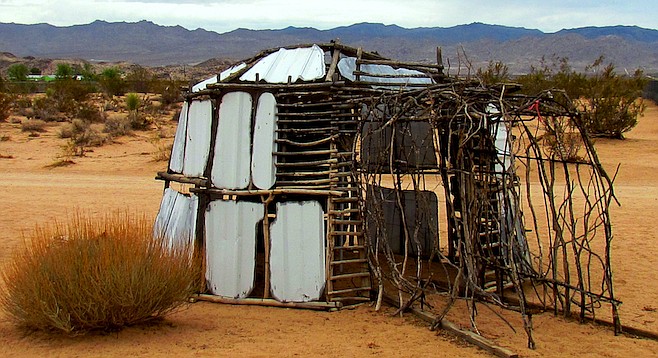 Facebook
Facebook
 X
X
 Instagram
Instagram
 TikTok
TikTok
 Youtube
Youtube

There isn’t anything spectacular about the town visually. Like many desert towns, the buildings along the main drag are old, unkempt and often vacant. There are few sidewalks, and no trees or landscaping that would entice travelers to stop unless they absolutely had to.
It just happens to be en route to Joshua Tree National Park as well as the military installation at 29 Palms. Otherwise, there doesn’t seem to be much of a draw. I mean, let’s face it; Joshua Tree’s in the middle of NOWHERE.
And perhaps that’s the charm. Because when I ask around, I learn that there’s in fact a large and active community of artists, musicians and general eclectics that reside in and/or frequent the area.
Reanna Alder, who’s filling herb jars at Grateful Desert Herb Shoppe & EcoMarket, tells me that “there’s quite a large L.A. refugee population here. The desert has a mystique for them and they come to get away.” So it wasn’t just U2.
When I investigate, I find world-class artists, a metaphysical institute designed by Frank Lloyd Wright and his son, a cultural center that includes a state-of-the-art playhouse and comedy club, and the High Desert Test Sites project that provides acreage throughout the region for artists to “generate physical and conceptual…art exploring the intersections between contemporary art and life at large.”
I also happen upon several outdoor sculpture gardens created by the following artists:
Antone Martin

Grand Canyon rejected his three-ton Christ, but a parish in Yucca Valley, just south of Joshua Tree, didn’t.
From 1950 until his death in 1961, Martin completed 50 biblical works from whitewashed, steel-reinforced concrete. His Desert Christ Park, which suffered in the '92 earthquake, was created to promote world peace. Non-biblical sculptures of his include the bronze "Goddess of Flight" located at the town’s Community Center and "Saber Tooth Tiger" installed at Remembrance Park.
Noah Purifoy
Believing that art should serve as a tool for social change, Noah Purifoy, born in Alabama in 1917, spent 11 years designing and implementing public policy for the California Arts Council and founded the Watts Towers Art Center before moving to the Mojave at 72 when his L.A. studio rent increased.
He spent the remainder of his life creating large-scale installation art consisting of 100 sculptures, assemblages of trash intended to accentuate consumer waste. Many of the pieces now housed in Purifoy’s Gallery and possibly some of the larger sculptures included in the outdoor museum will be included in a retrospective show that the Los Angeles County Museum of Art will be running on Purifoy in 2014.

As with Leonard Knight’s Salvation Mountain, weather and time and theft have taken their toll. For this reason, the Noah Purifoy Foundation seeks volunteers interested in assisting with the repair and upkeep of the aging outdoor exhibits.
The Outdoor Desert Art Museum is free and publically accessible. Reservations must be made to enter the visitor’s center and the gallery.
Andrea Zittel
Born in ’65 in Escondido, Zittel is an internationally recognized award-winning multimedia artist renowned worldwide for Indianapolis Island, a inhabitable experimental living exhibit in the middle of a lake at the Indianapolis Museum of Art.
Zittel is known more locally as the “Pod Lady” for her experimental living structures – compact, futuristic trailer-sized capsules, or pods. The pods are located at the experimental living “Encampment” outside of Joshua Tree National Park. The function of the encampment “is to lead participants outside of the normal range of their everyday living situations, and to allow them to reevaluate common assumptions about needs, values, and social norms.” It’s only open to visitors two months out of the year, April 15th to May 15th and throughout October.
A rare tour of the house, studio, Wagon Station Encampment, Homestead Cabin, Regenerating Field and shipping container compound will be conducted on Saturday, September 22, 5–7 p.m. Tours will run about two hours and are limited to 12 people. Advanced reservations, therefore, are required; email [email protected] for availability. $45/adult, $30/student.
Open Studios Events
Over the course of two weeks in late October, the eleventh-year Hwy 62 Art Tours will orchestrate open studio events, an aerial circus and laser light afterparty showcasing over 100 artists, one of which will be Joshua Tree’s Simi Dabah.
For 40 years, self-taught Dabah has been using industrial scrap to weld sculptures, most that he then allows to patina. Dabah, who donates sculptures to public and non-profit organizations, provides public access to his eight-acre Joshua Tree sculpture garden and studio only during this once-a-year event.
Past tours have also included California coastal native Gregory Howlind, who sculpts rustic metal creatures of the sea. (Not exclusively, but a giant whale does stand out against the rubbled high desert landscape in a way that his rusted scorpion doesn’t.)
Howlind's work can be seen at public installations along Route 62 through 29 Palms, and at his Wishing Whale Gallery in Joshua Tree.


There isn’t anything spectacular about the town visually. Like many desert towns, the buildings along the main drag are old, unkempt and often vacant. There are few sidewalks, and no trees or landscaping that would entice travelers to stop unless they absolutely had to.
It just happens to be en route to Joshua Tree National Park as well as the military installation at 29 Palms. Otherwise, there doesn’t seem to be much of a draw. I mean, let’s face it; Joshua Tree’s in the middle of NOWHERE.
And perhaps that’s the charm. Because when I ask around, I learn that there’s in fact a large and active community of artists, musicians and general eclectics that reside in and/or frequent the area.
Reanna Alder, who’s filling herb jars at Grateful Desert Herb Shoppe & EcoMarket, tells me that “there’s quite a large L.A. refugee population here. The desert has a mystique for them and they come to get away.” So it wasn’t just U2.
When I investigate, I find world-class artists, a metaphysical institute designed by Frank Lloyd Wright and his son, a cultural center that includes a state-of-the-art playhouse and comedy club, and the High Desert Test Sites project that provides acreage throughout the region for artists to “generate physical and conceptual…art exploring the intersections between contemporary art and life at large.”
I also happen upon several outdoor sculpture gardens created by the following artists:
Antone Martin

Grand Canyon rejected his three-ton Christ, but a parish in Yucca Valley, just south of Joshua Tree, didn’t.
From 1950 until his death in 1961, Martin completed 50 biblical works from whitewashed, steel-reinforced concrete. His Desert Christ Park, which suffered in the '92 earthquake, was created to promote world peace. Non-biblical sculptures of his include the bronze "Goddess of Flight" located at the town’s Community Center and "Saber Tooth Tiger" installed at Remembrance Park.
Noah Purifoy
Believing that art should serve as a tool for social change, Noah Purifoy, born in Alabama in 1917, spent 11 years designing and implementing public policy for the California Arts Council and founded the Watts Towers Art Center before moving to the Mojave at 72 when his L.A. studio rent increased.
He spent the remainder of his life creating large-scale installation art consisting of 100 sculptures, assemblages of trash intended to accentuate consumer waste. Many of the pieces now housed in Purifoy’s Gallery and possibly some of the larger sculptures included in the outdoor museum will be included in a retrospective show that the Los Angeles County Museum of Art will be running on Purifoy in 2014.

As with Leonard Knight’s Salvation Mountain, weather and time and theft have taken their toll. For this reason, the Noah Purifoy Foundation seeks volunteers interested in assisting with the repair and upkeep of the aging outdoor exhibits.
The Outdoor Desert Art Museum is free and publically accessible. Reservations must be made to enter the visitor’s center and the gallery.
Andrea Zittel
Born in ’65 in Escondido, Zittel is an internationally recognized award-winning multimedia artist renowned worldwide for Indianapolis Island, a inhabitable experimental living exhibit in the middle of a lake at the Indianapolis Museum of Art.
Zittel is known more locally as the “Pod Lady” for her experimental living structures – compact, futuristic trailer-sized capsules, or pods. The pods are located at the experimental living “Encampment” outside of Joshua Tree National Park. The function of the encampment “is to lead participants outside of the normal range of their everyday living situations, and to allow them to reevaluate common assumptions about needs, values, and social norms.” It’s only open to visitors two months out of the year, April 15th to May 15th and throughout October.
A rare tour of the house, studio, Wagon Station Encampment, Homestead Cabin, Regenerating Field and shipping container compound will be conducted on Saturday, September 22, 5–7 p.m. Tours will run about two hours and are limited to 12 people. Advanced reservations, therefore, are required; email [email protected] for availability. $45/adult, $30/student.
Open Studios Events
Over the course of two weeks in late October, the eleventh-year Hwy 62 Art Tours will orchestrate open studio events, an aerial circus and laser light afterparty showcasing over 100 artists, one of which will be Joshua Tree’s Simi Dabah.
For 40 years, self-taught Dabah has been using industrial scrap to weld sculptures, most that he then allows to patina. Dabah, who donates sculptures to public and non-profit organizations, provides public access to his eight-acre Joshua Tree sculpture garden and studio only during this once-a-year event.
Past tours have also included California coastal native Gregory Howlind, who sculpts rustic metal creatures of the sea. (Not exclusively, but a giant whale does stand out against the rubbled high desert landscape in a way that his rusted scorpion doesn’t.)
Howlind's work can be seen at public installations along Route 62 through 29 Palms, and at his Wishing Whale Gallery in Joshua Tree.
Comments